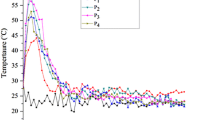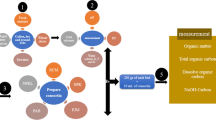Abstract
In India, flowers are widely used as an offering to Deities at religious places. Flower waste (FW) is rich in several nutrients and organic matter, therefore, can be utilized for the production of organic compost. This study investigated the potential of temple FW along with cow dung (CD) for the production of compost through aerobic valorization (AV) for 60 days. The FW was collected from the Mahan Shiv Parvati temple of Jammu, India. For this, laboratory-scale AV was done using a 1:3 mixture of FW and CD in a 20 kg capacity bin facilitated with aeration. The result showed that there was a significant increase (P < 0.5) in the nutrient values of formulated compost in terms of total Kjeldahl’s nitrogen (TKN: 63.70%), P2O5 (75.65%), K2O (86.27%), and organic carbon (OC: 52.41%), respectively. Besides this, the first-order reaction model described the maximum rate constants of TKN, P2O5, K2O, and OC as 0.0085, 0.0118, 0.016, and 0.0057% dw/day with an acceptable range of model fitness (R2 > 0.8805), respectively. This study showed that the AV process of FW and CD mixture gave compost of good quality which presents a sustainable waste management approach.





Similar content being viewed by others
References
Abdel-Shafy HI, Mansour MSM (2018) Solid waste issue: sources, composition, disposal, recycling, and valorization. Egypt J Pet. https://doi.org/10.1016/j.ejpe.2018.07.003
APHA (2005) Standard methods for the examination of water and wastewater, 20th edn. American Public Health Association, Washington
Awasthi MK, Pandey AK, BundelaPS KJ (2015) Co-composting of organic fraction of municipal solid waste mixed with different bulking waste: characterization of physicochemical parameters and microbial enzymatic dynamic. Bioresour Technol 182:200–207
Cáceres R, Malińska K, Marfa O (2017) Nitrification within composting: a review. Waste Manag 72:119–137. https://doi.org/10.1016/j.wasman.2017.10.049
Chu Y, Huang C, Xie X, Tan B, Kamal S, Xiong X (2018) Multilayer hybrid deep-learning method for waste classification and recycling. Comput Intell Neurosci. https://doi.org/10.1155/2018/5060857
CPCB (2013) Status report on municipal solid waste management. http://www.cpcb.nic.in/divisionsofheadoffice/pcp/MSW_Report.pdfhttp://pratham.org/images/paper
Devi E, Mugilvannan R (2018) Enhanced composting of market waste using effective microorganisms. Int Res J Eng Technol 5(11):645–652
Dutta S, Kumar MS (2021) Potential of value-added chemicals extracted from floral waste: a review. J Clean Prod 294:126280
Emadodin I, Reinsch T, Rottor A, Orlando-Bonaca M, Taube F, Javidpour J (2020) A prespective on the potential of using marine organic fertilizers for the sustainable management of costal ecosystem services. Environ Sustain 3:105–115. https://doi.org/10.1007/s42398-020-00097-y
EPW (2018) How can India's waste problem see a systemic change? Economic and political weekly. https://www.epw.in/engage/article/institutional-framework-implementing-solid-waste-management-india-macro-analysis. Accessed 8 Apr 2021
Gupta SK, Negru R, Voda M (2018) The Indian Himalaya`s unique attributes: Hemkund sahib and the valley of flowers. Geogr Technol 13(2):62–73. https://doi.org/10.21163/GT_2018.132.05
Jain N (2016) Waste Management of Temple Floral offerings by Vermicomposting and its effect on Soil and Plant Growth. Int J Agric Environ Res 2(7):89–94
Jariwala M, Bombaywala V, Deshani K, Choudhari K, Dhotre H, Solanki C (2019) Rotary drum composting of flower waste. Int J Eng Technol 6(4):1–6
Kulkarnia MB, Ghanegaonkar PM (2018) Methane enrichment of biogas produced from floral waste: a potential energy source for rural India. Energy Sour Part A. https://doi.org/10.1080/15567036.2019.1571126
Kumar P, Kumar V, Kumar S, Singh J, Kumar P (2020) Bioethanol production from sesame (Sesamum indicum L.) plant residue by combined physical, microbial and chemical pretreatments. Bioresour Technol 297:122484
Kumar V, Kumari S, Kumar P (2020) Management and sustainable energy production using flower waste generated from temples. In: Kumar V, Singh J, Kumar P (eds) Environmental degradation: causes and remediation strategies. Agro Environ Media Publication Cell of AESA, Haridwar, pp 154–165
Lim SL, Lee LH, Wu TY (2016) Sustainability of using composting and vermicomposting technologies for organic solid waste biotransformation: recent overview, greenhouse gases emissions and economic analysis. J Clean Prod 111:262–278. https://doi.org/10.1016/j.jclepro.2015.08.083
Mahindrakar A (2018) Floral waste utilization. Int J Pure Appl Biosci 6(2):1–5
Mulay Y, Owal S, Chougule P, Pandit A (2020) Composting of floral waste by using indigenously isolated microbial consortium: an approach towards the Environment sustainability and waste management. Int J Environ Agric Res 6(4):20–26
Murugan R, Loges R, Taub F, Joergensen RG (2013) Specific response of fungal and bacteria residues to one-season tillage and repetedslury application in a permanent grassland soil. Appl Soil Ecol 72:31–40
Oldfield TL, Sikirica N, Mondini C, López G, Kuikman PJ, Holden NM (2018) Biochar, compost and biochar-compost blend as options to recover nutrients and sequester carbon. J Environ Manag 218:465–476. https://doi.org/10.1016/j.jenvman.2018.04.061
Patil RN, Pustode K, Narse S, Yeole S, Kalsait M, Dakhole P (2019) A review of organic waste generation and its management with different techniques. J Constr Build Mater 5(2):14–20
Paturkar K, Kulkarni P, Shambharkar S (2020) Comparative study of vermi-cast generated from flower waste and leaf waste. Essence 11:1–10
Petric I, Selimbašić V (2008) Development and validation of mathematical model for aerobic composting process. Chem Eng J 139(2):304–317
Sharma A, Sharma R, Arora A, Shah R, Singh A, Pranaw K, Nain L (2014) Insights into rapid composting paddy straw augemented with efficient microorganism consortioum. Int J Recycl Org Waste Agric 3:54. https://doi.org/10.1007/s40093-014-0054-2
Sharma D, Varma VS, Yadav KD, Kalamdhad AS (2017) Evolution of chemical and biological characterization during agitated pile composting of flower waste. Int J Recycl Org Waste Agric 6:89–98. https://doi.org/10.1007/s40093-017-0155-9
Singh WR, Kalamdhad AS (2016) Transformation of nutrients and heavy metals during vermicomposting of the invasive green weed Salvinia natans using Eisenia fetida. Int J Recycl Org Waste Agric. https://doi.org/10.1007/s40093-016-0129-3
Vineetha MV, Priyanka R, Ananda HV, Sarwad S (2018) Paper production from flower recycling. J Alt Energy Sourc Technol 9(2):77–80
Waghmode MS, Gunjal AB, Nawani NN, Patil NN (2018) Management of floral waste by conversion to value-added products and their other applications. Waste Biomass Valoriz 9(1):1–11. https://doi.org/10.1007/s12649-016-9763-2
Wang Y, Witarsa F (2016) Application of Contois, Tessier, and first-order kinetics for modeling and simulation of a composting decomposition process. Bioresour Technol 220:384–393
WHO (2010) Handbook: good laboratory practice (GLP): quality practices for regulated non-clinical research and development (2nd ed) p 328
Xie X, Gao X, Pan C, Wei Z, Zhao Y, Zhang X, Cao J (2019) Assessment of multi origin humin components evolution and influencing factors during composting. J Agric Food Chem 67(15):4184–4192. https://doi.org/10.1021/acs.jafc.8b07007
Yadav A, Gupta R, Garg VK (2013) Organic manure production from cow dung and biogas plant slurry by vermicomposting under field conditions. Int J Recycl Org Waste Agricult 2:21. https://doi.org/10.1186/2251-7715-2-21
Yadav I, Juneja SK, Chauhan S (2015) Temple waste utilization and management. Int J Eng Sci Technol 2:1–6
Acknowledgements
The authors are grateful to the Department of Environmental Sciences, Central University of Jammu, Samba, Jammu and Kashmir, India for providing necessary experimental equipment and also the management committee of Mahan Shiv Parvati Temple for allowing us to conduct this research.
Funding
Not applicable.
Author information
Authors and Affiliations
Corresponding author
Ethics declarations
Conflict of interest
The authors declare that there is no conflict of interest.
Ethical approval
This Manuscript does not contain any studies with human participants or animals performed by any of the authors.
Additional information
Publisher's Note
Springer Nature remains neutral with regard to jurisdictional claims in published maps and institutional affiliations.
Rights and permissions
About this article
Cite this article
Kumari, S., Kothari, R., Kumar, V. et al. Kinetic assessment of aerobic composting of flower waste generated from temple in Jammu, India: a lab-scale experimental study. Environmental Sustainability 4, 393–400 (2021). https://doi.org/10.1007/s42398-021-00179-5
Received:
Revised:
Accepted:
Published:
Issue Date:
DOI: https://doi.org/10.1007/s42398-021-00179-5




